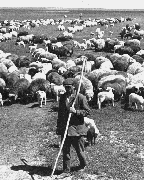![]()

![]()

|
The heads made of wood are often the most beautiful in terms of the color, figure of the grain, and the variety of what can be carved because there are few size restraints, so your imagination is the limiting factor in what can be created. Sadly, it is very difficult to find wood with sufficient curve of grain to follow the shape of the handle, so wooden crook heads are usually quite brittle in at least one spot on nearly every stick. |
This of course makes it very important not to drop them, and they are un-usable for hooking sheep. (Bent wood crooks are an exception to this, and are quite useful for catching sheep). If you find one that you like, and there are some wood heads of striking beauty, they are fine within their limitations. Some woods however are far better for heads than others. I have found that of those I have been able to try, the very strongest is Myrtlewood, which is only easy to find on the West Coast of Oregon. Fortunately it is also some of the most beautiful, and varied in color. Maple burl is also fairly strong, as is Elm if you can find it. Any wood head is improved if you can find in the raw material a place that the grain curves around a knot, or crotch in the wood, that at least partially strengthens the shortest grain of the handle. There are differing opinions regarding which direction the grain should go, but I have found that unless it follows the curve of the head, it should go with the direction of the shank. This is also true of horn heads in that the grain if the horn should be bent to match the flow of the handle, not cut to fit.
Horn heads are made of all kinds of sheep and goat horn, and Chinese water buffalo. The best horn I have been able to find is Scottish Blackface rams horn, and next is horned Dorset rams horn. All types of horn are hard to find with enough age on the live animal for the horn to have become sufficiently thick for stickdressing. Only the tip, approximately the outer 1/3, of the horn, is thick enough to make a market or show stick out of, so to be good they must be quite large. The smaller horns can only be used to make simple crooks even these still need extensive work to squeeze them up enough to close up the hollow part. Thin horn can sometimes be squeezed around a wooden peg, and then drilled for the pin, but too thin, and it's useless. Many breeds of sheep never get thick enough horns, but the ones that produce good horn must be at least 5 full years old to be of much use. The water buffalo is a little different. I rather like to use it because it is one of the few cash crops of the peasant farmers in India, China, and South East Asia. There they tend established heards of Buffalo for milk and meat, and because the horn is solid, with no pith, they can lop them off, and keep the buffalo if they want. It is a striking gray/black in color. Often it has white streaks through it and sometimes it has gold flecks. Unfortunately, like most horn, it is somewhat difficult to find, and is very different than ram's horn to work with. It also takes a tremendously long time to heat enough to bend, and unlike horn it will break if treated too severely. Horn must be dried for quite a while, six months to a year or it works with great difficulty, and sands poorly.

